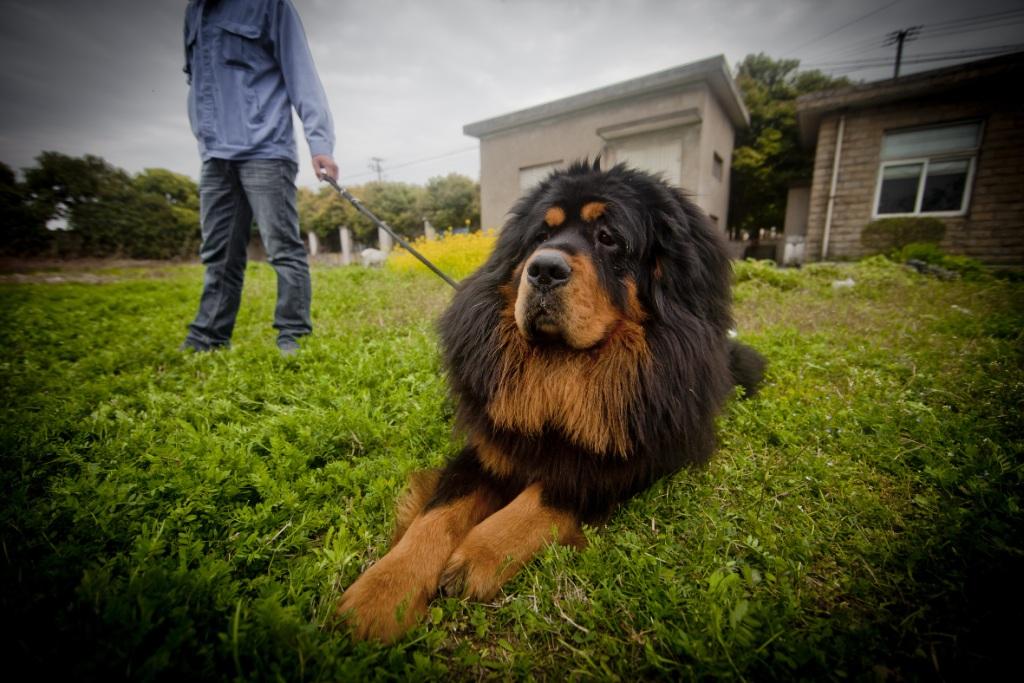Throwback Thursday is when we trawl through the That's archives for a work of dazzling genius written at some point in our past. We then republish it. On a Thursday.
By Hart Huguet Hagerty & Raemin Zhang, photos by Nicky Almasy
There’s no flowery Chinese name for Tibetan Mastiffs; they’re called exactly what they are: 藏獒 (zang ao), meaning 'ferocious Tibetan dog.' On a visit to Zhang Chunhua, one of East China’s top breeders, handlers warned us not to get too close or lock eyes with these one meter tall, 100 kg giants with slobbering jowls.
Well, duh.
Mastiffs look more like prehistoric beasts than tail-wagging Fido for a reason: a study by Nanjing Agricultural University revealed that they diverged from wolves about 58,000 years ago, whereas common domesticated pups split off some 42,000 years ago. The early divergence means zang ao possess stronger central canine qualities like pack mentality and guardian instinct.
 Tibetan Mastiffs are called zang ao 藏獒, meaning 'ferocious Tibetan dog.'
Tibetan Mastiffs are called zang ao 藏獒, meaning 'ferocious Tibetan dog.'
Need proof? One newspaper reported a pair of mastiffs killed tigers while guarding sheep in the highlands. So how does one care for a breed whose 2-month-old puppies weigh 20 kg? First up, food. Forget Kibbles n Bits. Twice a day, breeders steam up meat and veg in a cantaloupe-sized baozi. Breeders say many owners are in the daily habit of serving quality steaks to their beastly babies.
As for obedience training, there isn’t much. We witnessed mastiffs drag trainers grasping to chain leashes. Puppies are loyal from the start, but once grown up, sheer size makes them difficult to control. The handler’s only advice was, “If you buy a mature mastiff [2 year or older], lock it in a cage for three months until it recognizes you as its new master.”
Gulp.
Full-grown Tibetan Mastiffs sell for RMB3-5 million from breeders, but reliable sources say that whopping price is grossly inflated (the ‘hao pengyou’ price is much closer to RMB100,000). Still, that’s a lot of dough for a dog. So why the hefty price? Some people believe zang ao are holy animals capable of bringing riches and good health to their owners. Being China’s favorite color helps too: red-coated mastiffs sell for more.
 Being China’s favorite color helps: red-coated mastiffs sell for more.
Being China’s favorite color helps: red-coated mastiffs sell for more.
Maintaining a pure bloodline while avoiding inbreeding is tricky. From August to January, breeders from all over China meet to match up their mastiffs, but not just any bitch can mate with Zhang’s pedigreed champs, 传奇 (Chuanqi) and 红桥 (Hongqiao), which are both certified by China’s National Kennel Club.
The May 15 one-dog policy will ban mastiffs from the city center, meaning they’re only up for grabs for those wealthy few with stately suburban villas. But then that shouldn’t be any hardship for someone who can afford the slobbery mythical beast in the first place.

Breeder of China’s priciest pooch
Breeder Lu Liang thinks Big Splash, the Tibetan mastiff he recently sold for RMB10 million, is priceless. Here he explains what the big dog deal is all about...
If he’s priceless, why did you settle on RMB10 million?
Price depends on the bone structure, shoulder width, color and abundance of hair. Big Splash has a great red coat only seen once in a dozen years and huge 85cm shoulders. Not long before he was sold, there was a mastiff from Shandong with a similar look that sold for over RMB10 million, so I priced him equally.
Why do you think people are willing to pay so much?
I don’t think the mastiff is a status symbol. People buy my dogs because they really adore them and don’t just use them to show off. Actually, Chinese people have been raising mastiffs for over 1,000 years. They love mastiffs because they represent ideal characters of both dogs and human beings - loyal and great protectors of the family.
“Because mastiffs are big dogs, it’s very difficult sometimes for them to breed themselves, so we will stand by and help them out a bit.”
But mastiffs aren’t necessarily gentle giants, are they?
Mastiffs are very loyal, intelligent and fierce. In the highlands, one can fight against a pack of wolves. They’re also very wild animals, so I recommend raising one in a spacious outdoor area. The worst thing is that they’re so hard to train; however, many people just love how tough they are.
Are you selective about who you sell your dogs to?
Yes, I’m very selective about the buyers, but normally the people who come to me really adore mastiffs. I can tell from their words and eye contact. I never sell a dog to someone who just drops by. I usually wait until I get to know the buyer before selling. Afterwards, we keep in touch with updates of the dog’s life.
Are mastiffs difficult to breed?
We have very good facilities and professional staff, so our dogs have no mental or health problems. Because mastiffs are big dogs, it’s very difficult sometimes for them to breed themselves, so we will stand by and help them out a bit.























0 User Comments